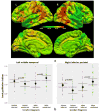Altered brain morphometry in 7-year old HIV-infected children on early ART
- PMID: 29209922
- PMCID: PMC5866746
- DOI: 10.1007/s11011-017-0162-6
Altered brain morphometry in 7-year old HIV-infected children on early ART
Abstract
Even with the increased roll out of combination antiretroviral therapy (cART), paediatric HIV infection is associated with neurodevelopmental delays and neurocognitive deficits that may be accompanied by alterations in brain structure. Few neuroimaging studies have been done in children initiating ART before 2 years of age, and even fewer in children within the critical stage of brain development between 5 and 11 years. We hypothesized that early ART would limit HIV-related brain morphometric deficits at age 7. Study participants were 7-year old HIV-infected (HIV+) children from the Children with HIV Early Antiretroviral Therapy (CHER) trial whose viral loads were supressed at a young age, and age-matched uninfected controls. We used structural magnetic resonance imaging (MRI) and FreeSurfer ( http://www.freesurfer.net/ ) software to investigate effects of HIV and age at ART initiation on cortical thickness, gyrification and regional brain volumes. HIV+ children showed reduced gyrification compared to controls in bilateral medial parietal regions, as well as reduced volumes of the right putamen, left hippocampus, and global white and gray matter and thicker cortex in small lateral occipital region. Earlier ART initiation was associated with lower gyrification and thicker cortex in medial frontal regions. Although early ART appears to preserve cortical thickness and volumes of certain brain structures, HIV infection is nevertheless associated with reduced gyrification in the parietal cortex, and lower putamen and hippocampus volumes. Our results indicate that in early childhood gyrification is more sensitive than cortical thickness to timing of ART initiation. Future work will clarify the implications of these morphometric effects for neuropsychological function.
Keywords: Cher; Cortical thickness; Gyrification; Morphometry; Neurodevelopment; Paediatric HIV.
Conflict of interest statement
Figures




Similar articles
-
Effects of perinatal HIV-infection on the cortical thickness and subcortical gray matter volumes in young adulthood.Medicine (Baltimore). 2021 Apr 16;100(15):e25403. doi: 10.1097/MD.0000000000025403. Medicine (Baltimore). 2021. PMID: 33847637 Free PMC article.
-
Similar cortical morphometry trajectories from 5 to 9 years in children with perinatal HIV who started treatment before age 2 years and uninfected controls.BMC Neurosci. 2023 Feb 24;24(1):15. doi: 10.1186/s12868-023-00783-7. BMC Neurosci. 2023. PMID: 36829110 Free PMC article.
-
Regional brain gray and white matter changes in perinatally HIV-infected adolescents.Neuroimage Clin. 2013 Oct 29;4:29-34. doi: 10.1016/j.nicl.2013.10.012. eCollection 2014. Neuroimage Clin. 2013. PMID: 24380059 Free PMC article.
-
Cortical structural changes related to early antiretroviral therapy (ART) interruption in perinatally HIV-infected children at 5 years of age.IBRO Neurosci Rep. 2021 Feb 10;10:161-170. doi: 10.1016/j.ibneur.2021.02.001. eCollection 2021 Jun. IBRO Neurosci Rep. 2021. PMID: 34179869 Free PMC article.
-
HIV infection and age effects on striatal structure are additive.J Neurovirol. 2019 Aug;25(4):480-495. doi: 10.1007/s13365-019-00747-w. Epub 2019 Apr 26. J Neurovirol. 2019. PMID: 31028692 Free PMC article.
Cited by
-
Effects of perinatal HIV-infection on the cortical thickness and subcortical gray matter volumes in young adulthood.Medicine (Baltimore). 2021 Apr 16;100(15):e25403. doi: 10.1097/MD.0000000000025403. Medicine (Baltimore). 2021. PMID: 33847637 Free PMC article.
-
Brain structure of perinatally HIV-infected patients on long-term treatment: A systematic review.Neurol Clin Pract. 2019 Oct;9(5):433-442. doi: 10.1212/CPJ.0000000000000637. Neurol Clin Pract. 2019. PMID: 31750029 Free PMC article. Review.
-
Altered White Matter Tracts in the Somatosensory, Salience, Motor, and Default Mode Networks in 7-Year-Old Children Living with Human Immunodeficiency Virus: A Tractographic Analysis.Brain Connect. 2022 May;12(4):302-319. doi: 10.1089/brain.2020.0948. Epub 2021 Aug 23. Brain Connect. 2022. PMID: 34107770 Free PMC article.
-
Multivariate approach for longitudinal analysis of brain metabolite levels from ages 5-11 years in children with perinatal HIV infection.Neuroimage. 2021 Aug 15;237:118101. doi: 10.1016/j.neuroimage.2021.118101. Epub 2021 May 4. Neuroimage. 2021. PMID: 33961998 Free PMC article.
-
Brain morphometric differences in youth with and without perinatally-acquired HIV: A cross-sectional study.Neuroimage Clin. 2020;26:102246. doi: 10.1016/j.nicl.2020.102246. Epub 2020 Mar 16. Neuroimage Clin. 2020. PMID: 32251906 Free PMC article.
References
-
- Ackermann C, Andronikou S, Laughton B, Kidd M, Dobbels E, Innes S, van Toorn R, Cotton M. White matter signal abnormalities in children with suspected HIV-related neurologic disease on early combination antiretroviral therapy. The Pediatric infectious disease journal. 2014;33(8):e207–12. 2014. - PMC - PubMed
-
- Ackermann C, Andronikou S, Saleh MG, Laughton B, Alhamud AA, van der Kouwe A, Meintjes EM. Early Antiretroviral Therapy in HIV-Infected Children Is Associated with Diffuse White Matter Structural Abnormality and Corpus Callosum Sparing. American Journal of Neuroradiology. 2016;37(12):2363–2369. - PMC - PubMed
-
- Andronikou S, Ackermann C, Laughton B, Cotton M, Tomazos N, Spottiswoode B, Mauff K, Pettifor JM. Corpus callosum thickness on mid-sagittal MRI as a marker of brain volume: a pilot study in children with HIV-related brain disease and controls. Pediatric radiology. 2015;45(7):1016–1025. - PubMed
-
- Benjamini Y, Hochberg Y. Controlling the false discovery rate: a practical and powerful approach to multiple testing. Journal of the royal statistical society Series B (Methodological) 1995:289–300.
Publication types
MeSH terms
Substances
Grants and funding
LinkOut - more resources
Full Text Sources
Other Literature Sources
Medical

